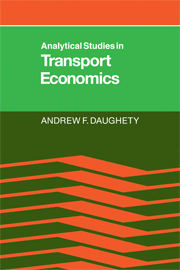Book contents
- Frontmatter
- Contents
- Contributors
- Preface
- INTRODUCTION
- TECHNOLOGY AND DEMAND
- EQUILIBRIUM, PRICING, AND MARKET BEHAVIOR
- 7 Freight network equilibrium: a review of the state of the art
- 8 Efficient pricing with rivalry between a railroad and a pipeline
- 9 Airline deregulation, fares, and market behavior: some empirical evidence
- Index
7 - Freight network equilibrium: a review of the state of the art
Published online by Cambridge University Press: 07 October 2011
- Frontmatter
- Contents
- Contributors
- Preface
- INTRODUCTION
- TECHNOLOGY AND DEMAND
- EQUILIBRIUM, PRICING, AND MARKET BEHAVIOR
- 7 Freight network equilibrium: a review of the state of the art
- 8 Efficient pricing with rivalry between a railroad and a pipeline
- 9 Airline deregulation, fares, and market behavior: some empirical evidence
- Index
Summary
The calculation of an equilibrium is fundamental to the positive analysis of any economic system. In this sense it is no surprise that one would wish to calculate an equilibrium among spatially separated markets connected by a freight transportation system, for that problem is evidently basic to regional and national economic forecasting. When the spatially separated markets of interest are represented as nodes of a network, the freight system infrastructure as links, together with some additional nodes to model modal or carrier junctions and transfer points, and some attempt to capture the complex hierarchy of decisions inherent in freight transportation is made, we refer to this equilibrium problem as the “freight network equilibrium problem.” What is a surprise to the uninitiated is that a theoretically rigorous representation of such an equilibrium and its efficient computation can be quite difficult, and that these are, to some extent, unsolved problems. In this chapter we endeavor to make this last point clear, to review some of the recent advances that have been made and to suggest future research necessary to a complete understanding of freight network equilibrium.
At first glance the freight network equilibrium problem, as we have described it so far, seems essentially the same as the spatial price equilibrium problem discussed in the seminal words of Samuelson (1952) and Takayama and Judge (1971).
- Type
- Chapter
- Information
- Analytical Studies in Transport Economics , pp. 161 - 206Publisher: Cambridge University PressPrint publication year: 1986
- 6
- Cited by

